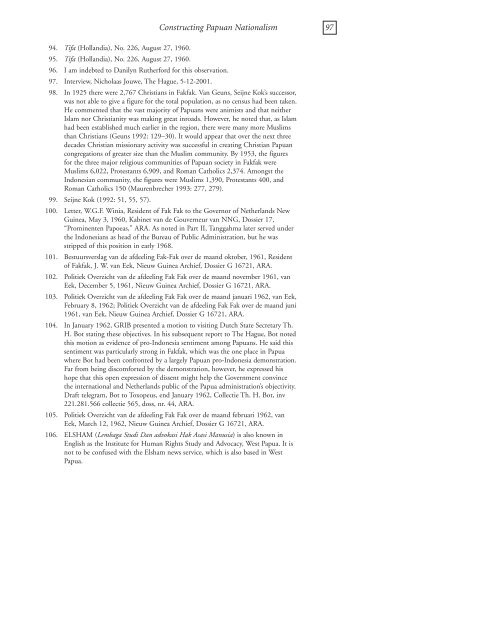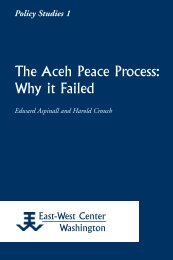Constructing Papuan Nationalism: History, Ethnicity ... - ScholarSpace
Constructing Papuan Nationalism: History, Ethnicity ... - ScholarSpace
Constructing Papuan Nationalism: History, Ethnicity ... - ScholarSpace
- No tags were found...
Create successful ePaper yourself
Turn your PDF publications into a flip-book with our unique Google optimized e-Paper software.
<strong>Constructing</strong> <strong>Papuan</strong> <strong>Nationalism</strong> 9794. Tifa (Hollandia), No. 226, August 27, 1960.95. Tifa (Hollandia), No. 226, August 27, 1960.96. I am indebted to Danilyn Rutherford for this observation.97. Interview, Nicholaas Jouwe, The Hague, 5-12-2001.98. In 1925 there were 2,767 Christians in Fakfak. Van Geuns, Seijne Kok’s successor,was not able to give a figure for the total population, as no census had been taken.He commented that the vast majority of <strong>Papuan</strong>s were animists and that neitherIslam nor Christianity was making great inroads. However, he noted that, as Islamhad been established much earlier in the region, there were many more Muslimsthan Christians (Geuns 1992: 129–30). It would appear that over the next threedecades Christian missionary activity was successful in creating Christian <strong>Papuan</strong>congregations of greater size than the Muslim community. By 1953, the figuresfor the three major religious communities of <strong>Papuan</strong> society in Fakfak wereMuslims 6,022, Protestants 6,909, and Roman Catholics 2,374. Amongst theIndonesian community, the figures were Muslims 1,390, Protestants 400, andRoman Catholics 150 (Maurenbrecher 1993: 277, 279).99. Seijne Kok (1992: 51, 55, 57).100. Letter, W.G.F. Winia, Resident of Fak Fak to the Governor of Netherlands NewGuinea, May 3, 1960, Kabinet van de Gouverneur van NNG, Dossier 17,“Prominenten Papoeas,” ARA. As noted in Part II, Tanggahma later served underthe Indonesians as head of the Bureau of Public Administration, but he wasstripped of this position in early 1968.101. Bestuursverslag van de afdeeling Fak-Fak over de maand oktober, 1961, Residentof Fakfak, J. W. van Eek, Nieuw Guinea Archief, Dossier G 16721, ARA.102. Politiek Overzicht van de afdeeling Fak Fak over de maand november 1961, vanEek, December 5, 1961, Nieuw Guinea Archief, Dossier G 16721, ARA.103. Politiek Overzicht van de afdeeling Fak Fak over de maand januari 1962, van Eek,February 8, 1962; Politiek Overzicht van de afdeeling Fak Fak over de maand juni1961, van Eek, Nieuw Guinea Archief, Dossier G 16721, ARA.104. In January 1962, GRIB presented a motion to visiting Dutch State Secretary Th.H. Bot stating these objectives. In his subsequent report to The Hague, Bot notedthis motion as evidence of pro-Indonesia sentiment among <strong>Papuan</strong>s. He said thissentiment was particularly strong in Fakfak, which was the one place in Papuawhere Bot had been confronted by a largely <strong>Papuan</strong> pro-Indonesia demonstration.Far from being discomforted by the demonstration, however, he expressed hishope that this open expression of dissent might help the Government convincethe international and Netherlands public of the Papua administration’s objectivity.Draft telegram, Bot to Toxopeus, end January 1962, Collectie Th. H. Bot, inv221.281.566 collectie 565, doss, nr. 44, ARA.105. Politiek Overzicht van de afdeeling Fak Fak over de maand februari 1962, vanEek, March 12, 1962, Nieuw Guinea Archief, Dossier G 16721, ARA.106. ELSHAM (Lembaga Studi Dan advokasi Hak Asasi Manusia) is also known inEnglish as the Institute for Human Rights Study and Advocacy, West Papua. It isnot to be confused with the Elsham news service, which is also based in WestPapua.
















